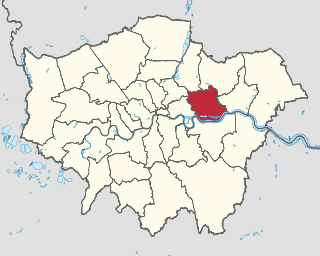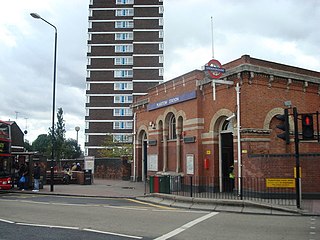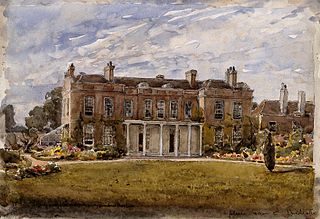Related Research Articles

The London Borough of Newham is a London borough created in 1965 by the London Government Act 1963. It covers an area previously administered by the Essex county boroughs of West Ham and East Ham, authorities that were both abolished by the same act. The name Newham reflects its creation and combines the compass points of the old borough names. Situated in the Inner London part of East London, Newham has a population of 387,576, which is the third highest of the London boroughs and also makes it the 16th most populous district in England. The local authority is Newham London Borough Council.

Plaistow is a suburban area of East London, England, within the London Borough of Newham. It adjoins Upton Park to the north, East Ham to the east, Beckton to the south, Canning Town to the south-west and West Ham to the west.

Upton Park is an area of the East London borough of Newham, centred on Green Street which is the boundary between West Ham and East Ham. West Ham United Football Club formerly played at the Boleyn Ground, commonly known as Upton Park.

The Boleyn Ground, often referred to as Upton Park, was a football stadium located in Upton Park, East London. It was the home of West Ham United from 1904 to 2016, and was briefly used by Charlton Athletic in the early 1990s during their years of financial difficulty. The seating capacity of the ground at closure was 35,016.

West Ham Park is a privately owned public park in West Ham in the London Borough of Newham. Spanning 77 acres (31 ha), it is the largest park in the borough. The park has been managed by the City of London Corporation since 1874.

West Ham is a constituency created in 1997 and represented in the House of Commons of the UK Parliament since 2005 by Lyn Brown, a member of the Labour Party.

West Ham was a local government district in the extreme south west of Essex from 1886 to 1965, forming part of the built-up area of London, although outside the County of London. It was immediately north of the River Thames and east of the River Lea.

Coade stone or Lithodipyra or Lithodipra is stoneware that was often described as an artificial stone in the late 18th and early 19th centuries. It was used for moulding neoclassical statues, architectural decorations and garden ornaments of the highest quality that remain virtually weatherproof today.

Green Street is a road in the London Borough of Newham, East London, which forms much of the boundary between East and West Ham.
Royal Docks Academy is a coeducational secondary school located in Custom House within the London Borough of Newham, England. It does not have a sixth form.
Ingersley Hall, later Savio House, stands to the east of the town of Bollington, Cheshire, England. The house was built in about 1775 for John Gaskell. Extensions were added to it in 1833 for John Upton Gaskell. The house was sold by the Gaskell family in 1933. In the 1950s it was taken over by a religious order, the Salesians of Don Bosco, and renamed Savio House. As of 2011 the house is used as a retreat and activities centre for young people. The front of the house is constructed in ashlar, with the remainder in coursed sandstone rubble. The house is roofed in Welsh slate and has stone chimneys. It has a rectangular plan and is in two storeys. The architectural style is Greek Revival. The north front is symmetrical with five bays divided by pilasters. The porch is in Doric style. The west front has eight bays, the central three of which were in the original house. All the windows in the north and west fronts are sashes with 12 panes. The south door is in Tuscan style, and was probably moved from the west front. The house is recorded in the National Heritage List for England as a designated Grade II listed building. Also listed at Grade II is a former coach house to the south of the hall, built in about 1850, and converted into a conference hall in about 1950.

St Mary's Church is a Church of England church in Plaistow in the (East-) London Borough of Newham. With the three churches of St Matthias’, St Martin's, and St Philip and St James’, it formed part of the Parish of the Divine Compassion. Its Victorian building, designed by Sir Arthur William Blomfield in 1890-1894, was demolished in 1976. They now worship in a smaller church built in 1981.
St Alban's Church, Upton Park is a Church of England church in the Upton Park area of East Ham in east London, England, dedicated to Saint Alban. It was founded by St Stephen's Church as a mission church on Boleyn Road in the Upton Park area around 1889, replaced by a small brick church on Wakefield Street in 1897. It was given a parish of its own in 1903, in which year the nave and aisle of a new permanent church on the opposite side of the same street were completed. Vestries, a Lady Chapel and chancel were added in 1934. Damaged by the London Blitz in 1940, it was repaired in 1949 and now forms part of the East Ham Team Parish alongside St Mary Magdalene's Church, St Bartholomew's Church and St Edmund's Church.

St Luke's Church, Canning Town or St Luke's Church, Victoria Docks is a Church of England church, originally housed in a building on Boyd Road in the Royal Docks area of West Ham in east London.
St Peter's Church was a Church of England church on Upton Lane in the Upton Cross area of Newham, East London. Its origins were in a mission of St Mary's Church, Plaistow on Pelly Road, holding services in a barn then in an iron church. Joseph Lister's former home Upton House was bought by the bishop of St Albans in 1885, becoming the vicarage, whilst its garden provided the site for a permanent church, built in 1893 and given a separate parish the following year using parts of those of All Saints, St Mary's, Emmanuel and St Stephen's. The parish was merged into that of Emmanuel in 1962 - the church was left standing as a chapel of ease to Emmanuel, but its vicarage was demolished, the site being sold in 1968. Funds from that sale and the sale of the parish hall were intended for a new church, church hall and clergy house, but in 1972 St Peter's Church was declared redundant, demolished and its site sold off, leading to the scheme's abandonment three years later.

Upton House was a building in West Ham, Essex on what is now the corner of Lancaster Road and Upton Lane It was rebuilt in 1731. In 1827, it was the birthplace of the surgeon Joseph Lister. In 1893 a temporary church for St Peter's Church, Upton Cross was set up in its gardens, with the house forming the vicarage - the permanent church was later built in the gardens. The vicarage was demolished in 1967-1968 and its site is now occupied by Joseph Lister Court.

Our Lady of Compassion Church is a Roman Catholic parish church in the Upton Park area of east London, dedicated to Our Lady of Compassion. Catholics in the area had previously worshipped at chapels attached to schools in the area until the church and its parish were both established in 1911.

West Ham Union Workhouse was a workhouse in Leytonstone, built in the village of Holloway Down between 1839 and 1841 and run by the West Ham Poor Law Union. That Union covered several parishes in what is now Newham, Redbridge and Waltham Forest. West Ham Borough Council took over its running in 1930 and renamed it the Central Home Public Assistance Institution, using it as a home for the infirm, aged and chronically sick. In 1948 it formally became a National Health Service hospital under the name of the Langthorne Hospital, which remained open until 1999.
Holloway Down was a village, historically in Essex and now part of Leytonstone in the London Borough of Waltham Forest. The village was sited at the junction of Union Lane and Leytonstone Road It is most notable as the location of the West Ham Union Workhouse, While the village has been replaced by Victorian terraces and shops, buildings from the workhouse remain; which have been converted into housing and part of North East London NHS Foundation Trust.

George Street, at the confluence of the A305 and A307 roads, is the high street in Richmond, London and was one of the first streets to be developed in the town. Previously known as Great Street, it was renamed after King George III in 1769. Buildings on the street include the Grade II listed Greyhound House, formerly the Greyhound Hotel, in a building dating from the 1730s.
References
51°32′30″N0°00′53″E / 51.5417°N 0.0148°E